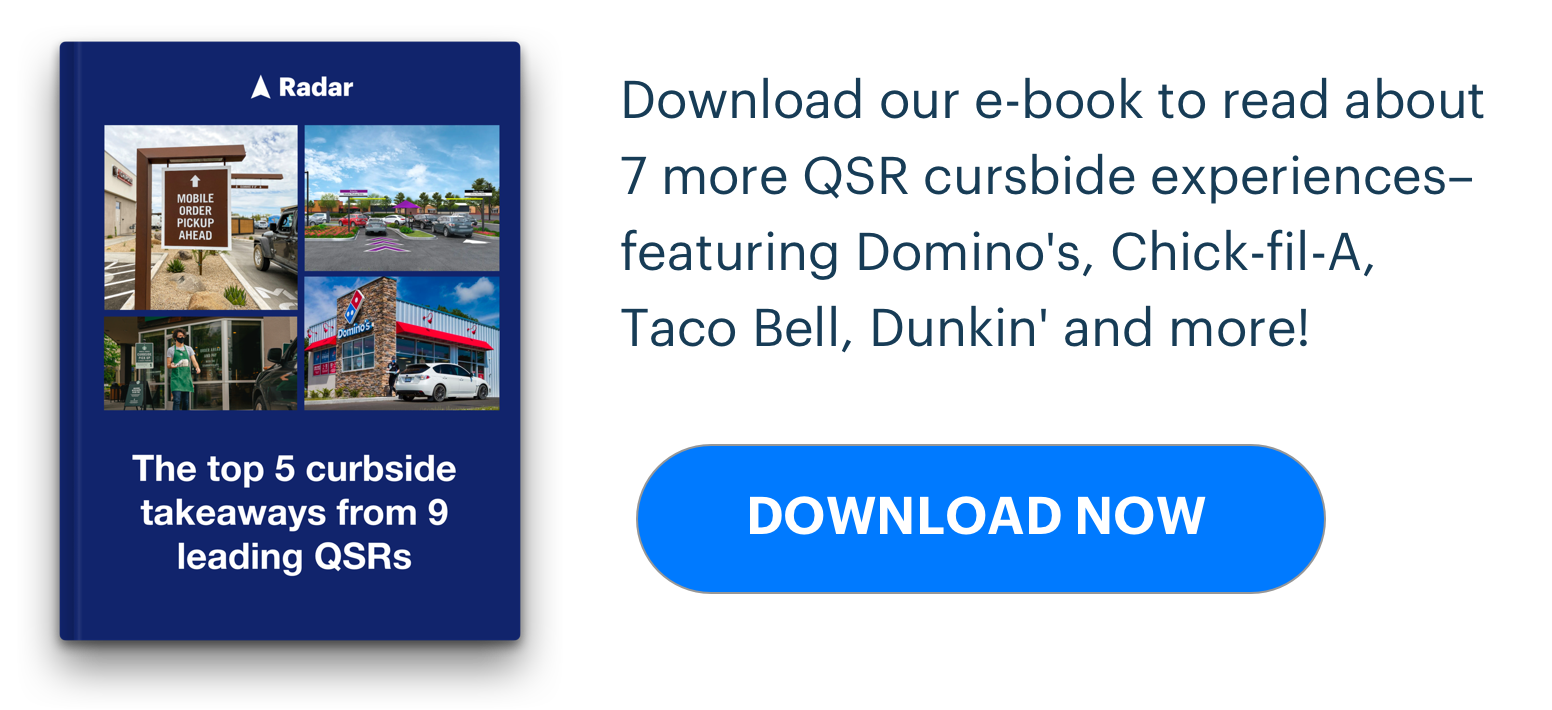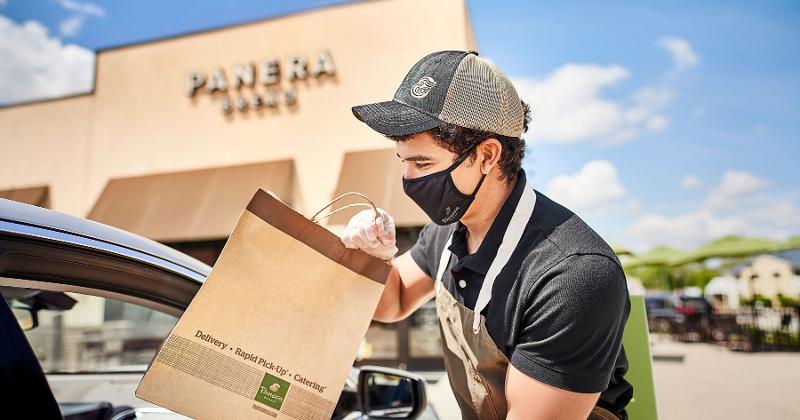How to thrive with curbside: lessons from the nation's leading restaurants
Mobile ordering, food delivery, and curbside pickup restaurants have transformed from mere conveniences to real lifelines for customers. Like video calls and virtual collaboration tools in the workplace, these services are the heroes of the restaurant and retail sector during this pandemic.
As COVID-19 spread, millions of Americans started relying on restaurant apps every day to satisfy their appetites using 3rd party meal pickup and delivery options. To keep up with rising demand, expectations, and competition, restaurants have had to improve their curbside experiences, optimizing for safety and convenience.
We've sampled nine of the nation's largest restaurant chains to find out what ingredients make a Michelin-Star curbside experience. To give you a taster: Location awareness and special drive-through lanes for curbside pickup are in, whereas manually tapping "I'm here" when you get to a restaurant . . . not so much.
Continue reading to see our reviews of Habit Burger and Panera, or download our eBook to read about all the curbside experiences we evaluated.

Habit Burger
As we'll see throughout this list, businesses that handled the pandemic well already had technology in place that could address the circumstances of the new normal (either through prescience or dumb luck). Habit Burger—the chain owned by Yum! Brands since March of this year—also had such a head start.
Originating in Santa Barbara, CA, its restaurants did well because they already had the right technology available to support curbside pickup and order-ahead services. The pandemic then lit a fire under those existing digital efforts, accelerating the adoption of its mobile app and the implementation of no-contact solutions.
COVID response
At the start of 2020, 60% of Habit Burger's revenue came from guests dining in, and only about 50 of its 276 locations offered drive-thru service. With the arrival of COVID, this all changed, and its other restaurants also implemented pop-up drive-thrus, no-contact drive-up, and no-contact curbside service in a hurry.
CEO Russell Bendel has seen "a shift in consumer behavior over the last couple of years." Still, due to the pandemic, consumers are now really expecting "to access your brand [and] order food in a very safe and convenient manner."
This shift certainly shows in Habit Burger's recent mobile app performance. Since refocusing its app around ease of ordering, customers have downloaded it 300,000 times in the past months, and the app still clocks in more than 2,300 downloads a day, even now.
Curbside pickup: What works well
The Habit Burger Grill mobile app has a clear user interface (UI), which makes it quick and convenient to place your order. Marking your order for curbside pickup is also easy, and the app shows your distance and travel time after selecting your preferred location.
Once ordered, a countdown timer shows when your food will be ready, which helps you plan your arrival. At the restaurant, pickup spots are easy to find because of distinct markings. This labeling helps avoid congestion, a common pitfall with implementing a smooth curbside experience.

Curbside pickup: What to improve
Habit Burger's app requires the manual entry of your location and expected arrival time. This step could easily be semi-automated through location services like geofencing. Such an improvement would make for a more convenient customer experience and, this being 2020, would also increase safety.
Besides cold food and unnecessary waiting, incorrect ETAs can also cause customers to leave their cars and go into the restaurant to check on their orders. This wandering increases the chance of close contact with staff and other customers.
Panera
Panera aims to become the "Netflix of coffee," and the chain lives up to that technology-derived analogy pretty well.
They launched an $8.99 monthly coffee subscription in late February that grew to half a million subscribers even during the pandemic. And from all brands on this list, Panera implemented curbside pickup in record time. Then, it blew past everyone else by making full use of the potential of geofencing to improve customer experience and safety.
Therefore, it's not surprising that the sandwich chain ranked number two on the Digital Maturity benchmark, ahead of McDonald's and other top performers on our list, Domino's and Chipotle.
COVID response
Early on in the pandemic, after identifying that its customers struggled to find basic groceries, Panera was one of a handful of restaurant chains to add items like milk and bread to its offerings.
The chain was also extremely fast in creating curbside pickup restaurants—seven days to get the service up and running at many of its locations. Now, curbside pickup accounts for 5% of sales.
Panera also took a page from Domino's cookbook by expanding the number of digital channels where it's active. In September, the chain added integration with Google services Search, Maps, and Assistant to ensure a faster and smoother ordering experience.
Curbside pickup: What works well
Panera is a textbook example of how to do online ordering and curbside pickup. It gets the basics right with the app and online experience, but it deserves a generous tip for its use of location-based technologies. By fully leveraging geofencing capabilities, Panera ensures customers don't have to manually alert staff when they arrive at a restaurant. Instead, employees receive automatic notifications, increasing safety and customer satisfaction by delivering orders right on time.

Another brilliant move is the coffee subscription. While this doesn't directly affect the curbside experience, it increases returning customer visits, which undoubtedly means increased traffic to its curbside as well.
Curbside pickup: What to improve
What is there not to like about Panera's approach? On an organizational level, we appreciate how its agility enables fast pivots in a difficult situation (not a given for a restaurant chain that manages thousands of locations and over 100,000 employees).
We also love how Panera makes full use of geofencing capabilities to create a better and safer customer experience for its curbside pickup restaurants.
Curbside pickup is here to stay through COVID and beyond
The pandemic altered consumer behavior and pressure-cooked restaurants into rapid and aggressive innovation. Many struggled to adapt to the new normal created by the coronavirus, but winners also emerged who not just handled the pressure but thrived.
A few of those successful restaurants are on our list; they’re the crème de la crème of curbside pickup restaurants as they were able to overcome the main challenges of what we like to refer to as "Curbside 2.0." These are their common ingredients that serve up an elite curbside experience:

If you're a technology or business leader investing in frictionless digital experiences tied to physical locations, contact our sales team. We’d love to hear from you.